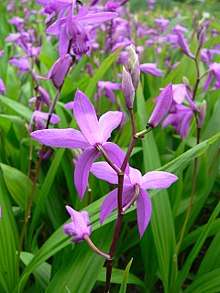Bletilla striata
| Bletilla striata | |
|---|---|
 | |
| Scientific classification | |
| Kingdom: | Plantae |
| Clade: | Angiosperms |
| Clade: | Monocots |
| Order: | Asparagales |
| Family: | Orchidaceae |
| Subfamily: | Epidendroideae |
| Genus: | Bletilla |
| Species: | B. striata |
| Binomial name | |
| Bletilla striata (Thunb.) Rchb.f. (1878) | |
| Synonyms[1] | |
| |
Bletilla striata, known as hyacinth orchid[2] or Chinese ground orchid,[3] is a species of flowering plant in the orchid family Orchidaceae, native to Japan, Korea, Myanmar (Burma), and China (Anhui, Fujian, Gansu, Guangdong, Guangxi, Guizhou, Hubei, Hunan, Jiangsu, Jiangxi, Shaanxi, Sichuan, Zhejiang).[1][4]
It forms a clump 50 centimetres (20 in) tall and wide, with sword-shaped leaves and bright pink flowers in Spring. In cultivation in the UK it is hardy in sheltered locations down to −10 °C (14 °F). It has gained the Royal Horticultural Society’s Award of Garden Merit.[2]
The Latin specific epithet striata means “striped”, in reference to the ribbed leaves.[5]
Uses
Bletilla striata is used in Asian traditional medicine for treating problems with the lining of the alimentary canal, e.g. ulcers.[6]
It is also used as a natural glue for making silk strings for traditional Chinese instruments like the guqin.[7]
References
- 1 2 Kew World Checklist of Selected Plant Families
- 1 2 "RHS Plantfinder - Bletilla striata". Retrieved 12 January 2018.
- ↑ "BSBI List 2007". Botanical Society of Britain and Ireland. Archived from the original (xls) on 2015-01-25. Retrieved 2014-10-17.
- ↑ Flora of China v 25 p 210, 白及 bai ji, Bletilla striata
- ↑ Harrison, Lorraine (2012). RHS Latin for Gardeners. United Kingdom: Mitchell Beazley. ISBN 184533731X.
- ↑ Chunming Wang; Jiantao Sun; Yi Luo; Weihua Xue; Huajia Diao; Lei Dong; Jiangning Chen; Junfeng Zhang (2006). "A Polysaccharide Isolated from the Medicinal Herb Bletilla striata Induces Endothelial Cells Proliferation and Vascular Endothelial Growth Factor Expression in vitro". Biotechnology Letters. 28 (8): 539–543. doi:10.1007/s10529-006-0011-x. PMID 16614890.
- ↑ Yu-Ku-Chai translation - Volume 3, Chapter 9: The Method for Making Strings http://web.cecs.pdx.edu/~jrb/chin/v39/v39.htm
External links

